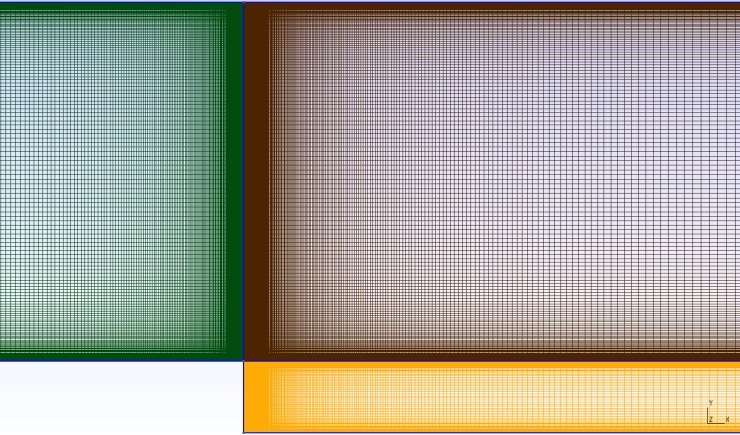In this example, I will be using the open source solver, simpleFOAM to solve the two-dimensional turbulent flow over a backward-facing step with a Reynolds number of Re = 5100. This Reynolds number is based on the step height, h = 0.1m as shown in Figure 1. I will be using the incoming velocity ,
, and
yielding
for the dynamic viscosity. I will be utilizing three different turbulent models Spalart-Alamars,
, and
SST with the aim to test each model’s accuracy against other numerical data. From extremely accurate direct numerical simulations (DNS), it has been determined that the reattachment of the separated boundary layer occurs on the bottom wall at
.

Figure 1: Geometry for turbulent flow over a backward-facing step.
Here are the sections of this post:
- Case-setup and Boundary Conditions
- Grid convergence study
- Results and Validation
- Conclusion
- Some Useful References
Download the case file here: SA-CaseFile
Assumptions
- Incompressible flow
- Turbulent flow
- Newtonian flow
- 2-Dimensional flow
- Negligible gravitational effects
- Sea level conditions
- RANS turbulence modelling without wall functions
Case Setup and Boundary Conditions
The boundary specifications are; an incoming turbulent intensity of 10% which corresponds to a turbulent kinetic energy of at the inlet. The outlet boundary is defined as an outflow condition while the no-slip condition is invoked for the rest of the computational walls. Show convergence histories, pressure contours for the entire flow region, and plot velocity vectors or pathlines. Discuss any observed flow characteristics. Use grids of varying densities to determine the sensitivity of the mesh to the reattachment point of the recirculation zone. Perform a grid convergence study using the reattachment location as the target quantity. Employ at least two different turbulence models.

Figure 2: quadrilateral mesh.
k-epsilon Boundary Conditions Setup

Calculations of  and
and 
The turbulent kinetic energy,, and turbulent dissipation rate,
, were calculated as:
whereis the mean velocity inlet. For turbulent intensity of
, the turbulent kinetic energy is
. The turbulent dissipation rate,
, is calculated as:
whereis the turbulent viscosity ratio. For internal flows
may be scaled with the Reynolds numbers. In our case, for
,
. Therefore,
.
SA Boundary Conditions Setup

Calculations of  and
and 
The turbulent eddy viscosity is computed from:
where
where
is a viscous damping function and $latex C_{\nu 1}$ is a constant equal to 7.1.
where
and
is the turbulent viscosity ratio, which is simply the ratio of turbulent to laminar (molecular) viscosity. For internal flows
may be scaled with the Reynolds numbers. In our case, for
,
. Therefore,
k-omegaSST Boundary Conditions Setup

Calculations of  and
and 
The turbulent kinetic energy,, and specific dissipation rate,
, were calculated as:
whereis the mean velocity inlet. For turbulent intensity of
, the turbulent kinetic energy is
. The turbulent dissipation rate,
, is calculated as:
whereis the turbulent viscosity ratio. For internal flows
may be scaled with the Reynolds numbers. In our case, for
,
. Therefore,
.
Grid Convergence Study
Three grids were made with number of nodes 7063, 29000, and 116248 respectively. According to NASA calculator for Re =5100 and ref. length 0.1, mesh spacing for the fine mesh should be 0.0002529. Mesh spacing for both the coarse mesh and medium were 0.0007529 and 0.0005529 respectively. Bases on the three grids, a grid convergence study was performed for each turbulent model to see how the results would vary. The three meshes used for SST model are shown in Figure (3). Table 4 provides the grid convergence study results for
SST model.








Figure 3: Shows coarse, medium, and fine mesh used for SST model.
Results and Verification






Figure 4: Shows the pressure and velocity distributions for each turbulent models used for the simulation.
From extremely accurate direct numerical simulations (DNS), it has been determined that the reattachment of the separated boundary layer occurs on the bottom wall at (note the origin of the coordinate system)

Conclusion
simpleFOAM has been verified for a classic example of an internal flow of a backward-facing step using three turbulent models in order to compare the results and how they affect the quantity of interests i.e. reattachment point. It has shown a great convergence study for the reattachment point. Boundary conditions for Spalat-Allmaras have been set up properly to resolve the boundary layer as well as with wall function (i.e.
) and
SST without wall function. Furthermore, a comparison between DNS and simpleFOAM for the reattachment point show reasonable agreements.